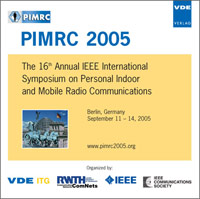Empirical Models and Parameters for Rural and Indoor Wideband Radio Channels at 2.45 and 5.25 GHz
Conference: PIMRC 2005 - 16th Annual IEEE International Symposium on Personal Indoor and Mobile Radio Communications
09/11/2005 - 09/14/2005 at Berlin, Germany
Proceedings: PIMRC 2005
Pages: 5Language: englishTyp: PDF
Personal VDE Members are entitled to a 10% discount on this title
Authors:
Laselva, Daniela; Zhao, Xiongwen; Meinilä, Juha (Elektrobit Ltd, Tutkijantie 7, 90570 Oulu, Finland)
Abstract:
The modeling results from wideband radio channel measurements are presented for two environments: rural and indoor. The paper focuses on the average and instantaneous characteristics of received power including: path loss, shadow fading, power delay profiles, and rms delay spreads. Furthermore, the cross correlation between shadowing of the path loss and the delay spread is investigated and found to be large. Doppler measurement campaigns were conducted in both environments, at 2.45 GHz and 5.25 GHz along the same measurement routes, with 100 MHz bandwidth. In this paper it is shown that we may apply 2.45 GHz band small scale models into 5.25 GHz band. It can be also seen, as for the measured scenarios, on average, the difference in terms of path loss between 2.45 GHz and 5.25 GHz in line-of-sight indoor environment, where waveguide effect is encountered, is c.a. 8 dB, instead in rural outdoor the mentioned difference is c.a. 6 dB.


